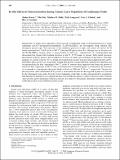| dc.contributor.author | Kwon, Jinhee | |
| dc.contributor.author | Dai, Min | |
| dc.contributor.author | Halls, Mathew D. | |
| dc.contributor.author | Langereis, Erik | |
| dc.contributor.author | Chabal, Yves J. | |
| dc.contributor.author | Gordon, Roy Gerald | |
| dc.date.accessioned | 2009-10-13T15:42:03Z | |
| dc.date.issued | 2009 | |
| dc.identifier.citation | Kwon, Jinhee, Min Dai, Mathew D. Halls, Erik Langereis, Yves J. Chabal, and Roy G. Gordon. 2009. In-situ infrared characterization during atomic layer deposition of lanthanum oxide. Journal of Physical Chemistry C 113, no. 2: 654-660. | en_US |
| dc.identifier.issn | 1932-7447 | en_US |
| dc.identifier.uri | http://nrs.harvard.edu/urn-3:HUL.InstRepos:3347570 | |
| dc.description.abstract | Mechanisms of atomic layer deposition (ALD) growth of lanthanum oxide on H-terminated Si(111) using lanthanum tris(N,N′-diisopropylacetamidinate) (La(iPr-MeAMD)3) are investigated using infrared (IR) absorption spectroscopy. The reactivity of this amidinate precursor is high, with almost all surface Si−H bonds consumed after 5 ALD cycles at 300 °C. Gas phase IR spectra show that, although most of the precursor (La(iPr-MeAMD)3) remains intact, a strong feature at 1665 cm−1, characteristic of a hydrogenated and dissociated free ligand with localized electrons in the N−CN bonds, is present. Such partial precursor dissociation in the gas phase is due to hydrolysis by traces of water vapor remaining in the reactor, even after purging. As a result, some Si−O−La bonds are formed upon reaction with the surface during the first La(iPr-MeAMD)3 pulse, prior to any water pulse. During film growth, acetate/carbonate and hydroxyl impurities are incorporated into the film. Annealing to 500 °C in dry N2 removes these impurities but fosters the growth of interfacial SiO2. Deposition at 300 °C leads to decomposition of adsorbed ligands, as evidenced by the formation of cyanamide or carbodiimide vibrational bands (or both) at 1990 and 2110 cm−1, respectively. Despite this decomposition, ideal self-limited ALD growth is maintained because the decomposed ligands are removed by the subsequent water pulse. Growth of pure lanthanum oxide films is often characterized by nonuniform film thickness if purging is not complete because of reversible absorption of water by the La2O3 film. Uniform ALD growth can be maintained without a rigorous dry purge by introducing alternating trimethylaluminum (TMA)/D2O ALD cycles between La/D2O cycles. | en_US |
| dc.description.sponsorship | Chemistry and Chemical Biology | en_US |
| dc.language.iso | en_US | en_US |
| dc.publisher | American Chemical Society | en_US |
| dc.relation.isversionof | http://dx.doi.org/10.1021/jp806027m | en_US |
| dc.relation.hasversion | http://www.chem.harvard.edu/groups/gordon/publicationsearch.html | en_US |
| dash.license | LAA | |
| dc.title | In-situ Infrared Characterization During Atomic Layer Deposition of Lanthanum Oxide | en_US |
| dc.type | Journal Article | en_US |
| dc.description.version | Version of Record | en_US |
| dc.relation.journal | Journal of Physical Chemistry C | en_US |
| dash.depositing.author | Gordon, Roy Gerald | |
| dc.date.available | 2009-10-13T15:42:03Z | |
| dc.identifier.doi | 10.1021/jp806027m | * |
| dash.contributor.affiliated | Gordon, Roy | |


